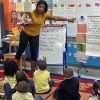Toccara Frederick started her pre-K class at Liberty Elementary school recently by discussing the theme of “People in a family can be many different shades” from the book Shades of People by Shelly Rotner.
She identified “family” and “shades” as new vocabulary words and asked her students whether members of their families were one shade or many shades. Three shades were identified in the book—peach, tan and coffee. One 4-year-old student said, “My dad is coffee, my mom is more peach, and I am coffee like my dad.”
Frederick’s pre-K class is participating in the final year of a three-year study of the Story Talk program, developed by researcher Barbara Wasik and instructional coach Mary Alice Bond of the School of Education’s Center for the Social Organization of Schools (CSOS), to find new ways to help teachers improve the vocabulary of young students in low-income communities. (More than 90 percent of the children at Liberty Elementary qualify for federally subsidized lunches.) Story Talk is funded by $1.5 million grant from the U.S. Department of Education.
In 1995, two Kansas researchers brought the word gap to national attention. The seminal research by Betty Hart and Todd Risley found that children from middle-income families were exposed to 30 million more words by age 3 than a child from a disadvantaged family. Follow-up studies show these differences had a lasting effect on a child’s performance in school and also in employment later in life.
More recently, a 2013 Stanford University study found that a language gap can appear as early as 18 months for low-income children and can grow significantly by age 2.
Jumpstart, an organization dedicated to early childhood education, wrote in a 2009 report, America’s Early Childhood and Literacy Gap, that “The most disturbing fact about this issue (word gap) is that it is entirely preventable. The solution is cost-effective and begins before a child even reaches kindergarten.”
Wasik said the earlier vocabulary begins building in a child’s life, the more likely gaps will be closed in vocabulary skills. “It’s important to reach the child before they enter kindergarten because that’s where they are taught the formal aspects of learning to read,” she said. “If they don’t have the vocabulary to understand what’s being taught, they will fall behind and unfortunately stay behind.”
Story Talk was designed with teachers in mind so they could focus on delivering high-quality instruction centered on vocabulary. It easily fits into most school-literacy curriculums. The research-based program emphasizes proven learning principles, including repeated exposure to new words, relating new vocabulary to a student’s life experience and using pictures or props to help define words.
Wasik said the program is in in the evaluation phase. There are a total of 30 classes involved in five Baltimore City schools. Half the classes use Story Talk and the other half comprise the comparison group that don’t use any outside vocabulary intervention. Teachers in the tested group receive coaching and monthly professional development. The final results should be published in the fall of 2017.
Another component of the study is Story Talk at Home that involves parents and caregivers. The at-home program provides families with short, fun activities using the same vocabulary as is used in the classroom.
Preliminary results from participating teachers suggest that Story Talk has a very positive effect on increasing vocabulary. Frederick said, “The program promotes strong vocabulary development for my preschoolers. Students have an opportunity to learn about 10 new words each week and are encouraged to use them often. Story Talk provides rich language and is enjoyable for the children as well as myself.’
Wasik has seen the field of early childhood education expand considerably since she began working for CSOS in 1994. “The importance we give to early childhood is very different than just a generation ago. Research has shown that children can think and learn differently depending on their age,” she said. “We know that the way information is delivered to a 3-year-old is much different from the way it’s delivered for 4- and 5-year-olds. The goal is to get teachers to focus on ability and age, and where the child is.”
Wasik faults district leaders and superintendents for failing to acknowledge the importance of pre-K programs when they refer to K-12 education. “It should be pre-K to12. For many, pre-K is still an afterthought in many districts. It doesn’t make sense in this day and age not to start with pre-K given all we know about the importance of early learning.”
She did note that a few states, such as New York, have initiated universal pre-K programs so all children can benefit from an early start. A 2012 study of third-grade reading skills by Donald Hernandez of Hunter College, commissioned by the Annie E. Casey Foundation, found that children with poor reading skills by the third grade are four times more likely not to graduate from high school on time than students proficient in reading.
Research has clearly identified vocabulary development as an important predictor of children’s success in learning to read and success in school, Wasik said. “Now we need to focus on supporting teachers to effectively implement strategies in classrooms to close the achievement gap for children in poverty.”

